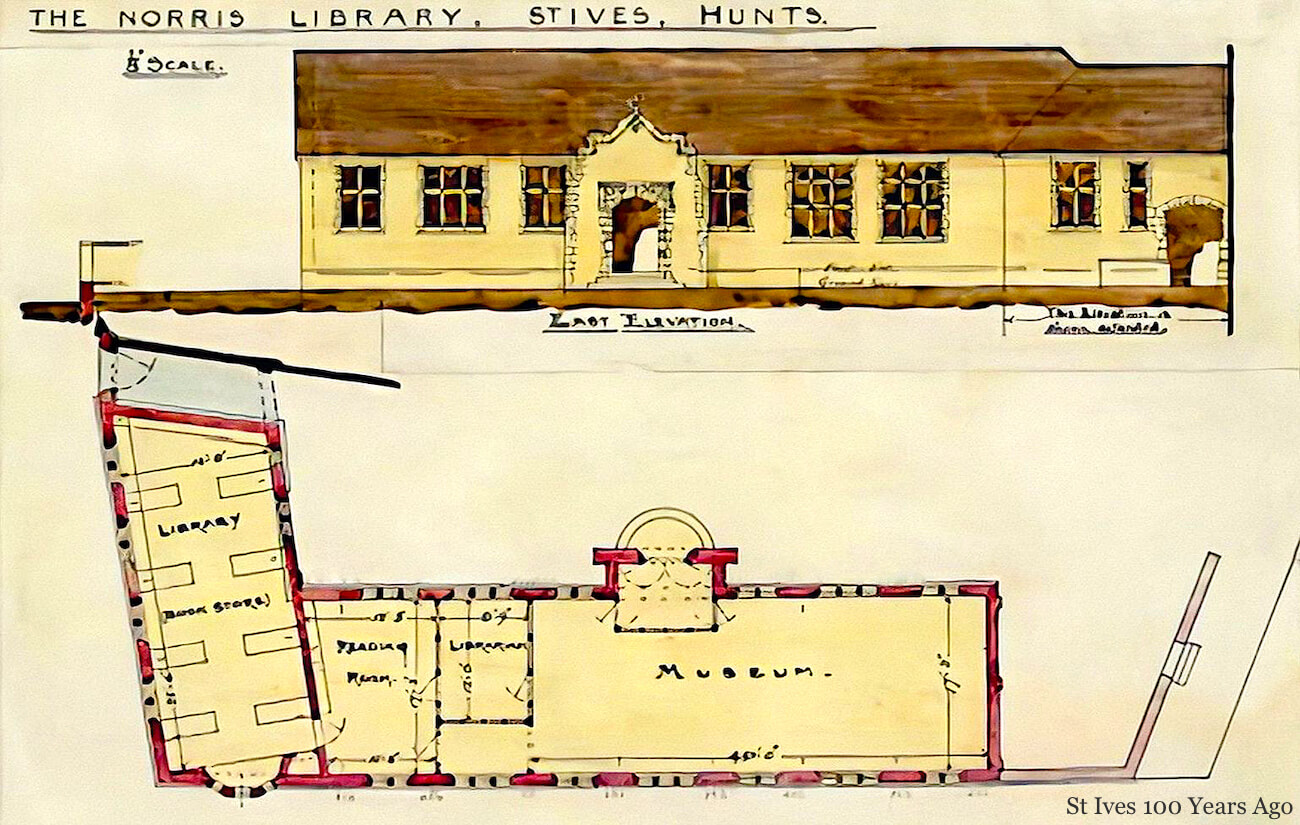When Herbert Norris died in 1931, he left his £1million estate and prodigious local history collection to St Ives Town Council. His will, written some 30 years before his death, stated a library was to be built to house his collection. If the Council did not action his will within twelve months, the entire estate passed to the Cambridge Antiquarian Society.
Anyone who views Herbert's papers will know he was an enthusiastic scribbler. No less so with his will. It showed he intended to provide for his sister and employees. When the Council tried to do the decent thing and action what they thought were Herbert's wishes, they landed up in court. Read on to learn how St Ives came close to losing the Norris Museum, how the museum almost became a bitter irony for Herbert's impoverished sister, and of Herbert's life.
Early years
Born 1859 in St Ives, Herbert was the eldest child of Ellis Norris and Hannah Munsey. The Norris family was an established boot and shoemaker in the town. Herbert's father and Uncle George traded from 16 Crown Street. His grandfather John ran his business from West Street.
By 1871 the family lived in Vine Cottage, Crown Walk. Herbert had a younger brother, Arthur, and sister, Emily Kate. Herbert attended the Manchester House School, later named St Ives Grammar School. In 1876 Arthur died, aged 14 years.
An interest in natural history developed a love of photography. In 1886, Herbert advertised himself as a photographer. He was interested in the past and wrote about the history of St Ives.
Herbert began work dealing in jewellery and silver. His uncle, David Munsey, employed Herbert at his jewellery business in Market Hill, Cambridge.
Move to Cirencester
By 1891 Herbert was in Cirencester. He boarded with Charlotte Heath, a widow and boarding-house keeper, at 58 Lewis Lane. Herbert took over the business of J Seymour Tanner, a jeweller and silversmith of 15 Market Place, Cirencester, and lived over the shop. Business was good. In 1901 Herbert had three servants tending to his needs.
 |
| Herbert's shop in Cirencester. |
Herbert must have been homesick for his native St Ives. He started collecting anything he could lay his hands on about Huntingdonshire. His interests ranged widely. In 1896 a local newspaper reported him as a founder member and president of both the local chess club and the Naturalist's and Archaeologists' Club. He had a similar role in the local caged bird society. Herbert kept in contact with his birthplace. He took periodic trips back to St Ives. Herbert was an original member of the Cambridgeshire and Huntingdonshire Archaeological Society.
Later years
Herbert never married. In retirement, he seemed to plan a return to Huntingdonshire to live. He bought Ferrar House, High Street, Huntingdon. He was to open a county museum to house his prodigious collection of books, documents, prints, paintings, photographs and objects about the history of the local area. Herbert died on his 72nd birthday in 1931 and is buried at Cirencester.
.jpeg) |
| Herbert's study at Cirencester, full of material on the local history of Huntingdonshire. |
The Gloucester Citizen reported the value of Herbert's estate at £20,000 (today, £1million). In his will dated some 30 years before his death, Herbert left everything to what is today St Ives Town Council. They were to establish a library and museum. If St Ives did not enact the will as written within twelve months, the whole estate would go to the Cambridge Antiquarian Society.
It was clear Herbert intended to alter his will. In his later years he provided for his sister Emily. His aged employees were loyal and loss of employment would impoverish them. Pencilled notes on his will indicated his latest wishes.
St Ives Town Council in trouble
The Town Council did the decent thing. They started paying Emily an annuity of £3 a week (today £7,500 a year). They sold the Cirencester shop to Herbert's manager on favourable terms. They paid £50 (today £2,500) to Albert Hughes, another employee.
The Cambridge Antiquarian Society challenged the administration of the will. If they could prove St Ives had misused the funds, the whole estate would pass to them. St Ives halted a payment to the last employee, Elsie Pope. The Gloucester Citizen interviewed Charles Coote. Charles was Mayor of St Ives the year before, when the Town Council made the payments. He was amazed and dumbfounded at the position the Town Council found itself in.
The Peterborough & Hunts Standard reported on the court case in August 1932. The lump sum payments, sale of the shop and the amounts paid to Herbert's sister were to stand. The Town Council were to make no more payments. All the remaining money must be spent on setting up the Norris Museum.
St Ives Town Council had a narrow escape. But Herbert's sister faced the bitter irony of living in poverty whilst regularly passing the Norris Museum, a prominent display of Herbert's wealth.
 |
| Norris Museum plans by Sidney Inskipp Ladds. |
The Norris Museum opens
The Town Council bought the site of an old malting near the Waits. Sidney Inskip Ladds, architect and local historian, design the museum. It opened in 1933.
Herbert's sister Emily was secretary of the museum. Elsie Pope moved from Cirencester to St Ives to become the museum's first curator. The Town Council had found a way to pay both an income.
Emily died in 1936, aged 72 years. Her obituary appeared in the Saffron Walden Weekly News. Elsie Pope died in 1946.

.jpeg)
.jpeg)

No comments:
Post a Comment